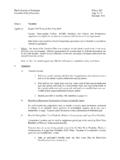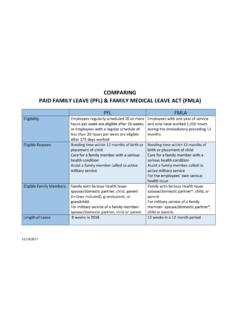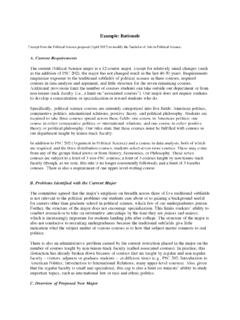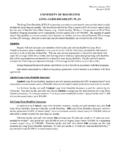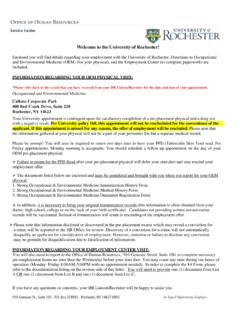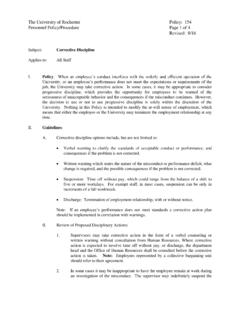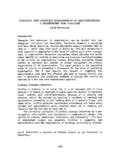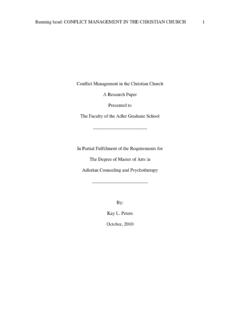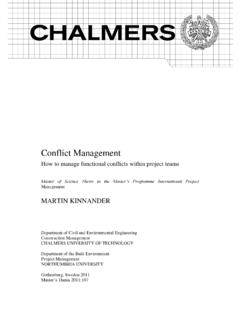Transcription of Conflict Management F2015 - University of Rochester
1 Conflict Management Advice for Negotiating Conflict in Your Professional Life Katherine Schaefer, PhD Biologist and Writing Instructor Volunteer Mediator and Circle Facilitator Member ACR and former Board Member, Partners in Restorative Initiatives Your professional success depends on how well you manage Conflict Why consider how to handle Conflict ? You will have it Your success depends on managing it People have long memories Properly handled Conflict can lead to better outcomes than the status quo What is Conflict ? From the dictionary: fight, battle, controversy, struggle, discord of action, incompatibility; a state of open fighting; to come into collision, disagreement; fight or contend What is Conflict ? From the Conflict resolution community: Conflict is when two or more values, perspectives and opinions are contradictory in nature Conflict is a disagreement where the parties involved perceive a threat to their needs which is resolved when a mutually satisfactory solution is achieved Exploring opinions, improving processes, creative solutions Intellectual argument No dislike or emotional difficulties Opportunity Open break Communication impossible Avoidance, rigid thinking The other party is bad Solutions are still possible Some avoidance and emotional difficulties People can salvage the relationship Badly handled Conflict makes things worse Alert!
2 Overview Conflict resolution styles Parsing out Conflict in common scenarios: VPN analysis TRIP goals analysis Communication techniques and self-knowledge Before we start Conflict styles Find the Welcome worksheet Take 2 minutes to jot down one Conflict in your life that has given you significant difficulty Find the Conflict Resolution Styles handout this survey is widely available; I got this version from the LA school district website, and a similar one is available from the UNC nursing school website. Just Google Conflict Management shark bear What s your Conflict Management style? (your LOWEST score) We will restart in 6 minutes Competing Shark Sharks use a forcing or competing Conflict Management style; goals > relationships Shark: Do it my else! Advantages: Immediate short term gain Rapid decisions Possible long term benefit (if truly correct) Disadvantages: Relationships damaged Avoiding Turtle Turtles avoid conflicts at all costs Turtles: I give up; I just won t be around.
3 Advantages: Relationships may be maintained Disadvantages: Conflict lingers Turtle failure and possible team failure Long-term resentments Accommodating Teddy Bear Bears use a smoothing or accommodating Conflict Management style; relationships> goals Bears: It s OK, I ll make it (somehow). Advantages: Relationship maintained Disadvantages: Bear taken advantage of; possible bear failure Long-term resentments Compromising Fox Foxes use a compromising Conflict Management style; concern is for goals AND relationships Fox: I ll give you this if you give me that. Advantages: Relationships maintained Solutions found Disadvantages: Jump too fast to the first obvious solution Optimal solutions missed Collaborating Owl Owls use a collaborating Conflict Management style valuing their goals AND relationships Owls: Let s fix this so we all get ahead.
4 Advantages: Relationships are maintained and best possible solutions obtained Disadvantages: Time and difficulty Possible need for an outside facilitator Awareness: try to work toward fox or owl Short term benefits vs. long-term goals If you tend toward shark behavior: You get immediate rewards BUT people have long memories If you tend toward turtle or teddy bear behavior: You avoid Conflict BUT your academic career may be hurt Choose your style depending on the Conflict (and your partner) Shark (win/lose) Owl (win/win) Bear (lose/win) Turtle (lose/lose) (lose/win) fox Concern for relationships Concern for goals Long-term planning Team efforts Rarely if ever Unpopular but necessary decisions Lose the battle; win the war Low impact compromises Overview Conflict resolution styles Parsing out Conflict in common scenarios: values, perceptions, and needs (VPN) TRIP goals Communication techniques and self-knowledge Two ways of looking at the same thing: Conflict is not (just) about the issue VPN (values, perceptions, needs) Mayer, The Dynamics of Conflict Resolution TRIP (topic, relationship, identity, process) Wilmot and Hocker, Interpersonal Conflict Some common grad school issues.
5 Being stuck on a project that isn t right for you Not getting the type of feedback you need Not having time to do everything and to focus on your own research Feeling that you are doing more than your share of the work or of less attractive projects/scutwork Worrying about authorship and apportioning credit General classes of Conflict Conflict in a hierarchical situation Advisor-student relationships; teacher-student relationships; boss-employee relationships Conflict within hierarchical overlapping spheres of influence Interdisciplinary projects; student/advisor/committee Conflict ; authorship disputes; multiple advisors Conflict in a team situation Laboratory- or field-based studies; team teaching responsibilities; collaborations Parsing out Conflict : VPN analysis Value: worth, importance, desirability Perception: how you see or a situation Need: requirement VPN: Conflict in a hierarchical relationship Values Priority setting between goals Knowledge of overarching goals may be unequally shared Perceptions Who should have decision-making power; autonomy within roles; what constitutes meeting a goal; process vs.
6 Product Needs Clear definition of roles and non-contradictory incentives Resources necessary to do the job and ability to succeed Respect, influence, self-efficacy, to be heard Conflict between members of a team Values Priority setting between goals Perceptions How things are going; most feasible way to reach goals Needs Clear definition of roles Non-contradictory incentives Resources necessary to do the job and ability to succeed Respect, influence, self-efficacy You try VPN for your favorite Conflict (we will re-start in 5 min) Values Perceptions Needs: and these are valid! Tangible Intangible Parsing out Conflict : TRIP analysis Topic goal: what is this Conflict nominally about? Relationship goal: what do the participants want in terms of the relationship(s)? Identity goal: how do the participants want to see themselves and be seen by others? Process goal: what processes do the participants think should be used to solve the Conflict ?
7 Conflict in most graduate school relationships Topic goal Probably shared, but maybe imperfectly understood Relationship goal Desire to maintain status Desire to be seen as an equal or a contributor Identity goal All participants may have multiple identity goals Nice guy? Authority? Friend? Process goal You try TRIP for your favorite Conflict (we will re-start in 5 min) Topic goal Relationship goal Identity goal Process goal 2 minute reflection (worksheet) What did I learn from these exercises that I can apply to my approach to Conflict ? Did you have a preference for VPN or TRIP? Why? How aware of these issues were you for your favorite Conflict before you did the analysis? What types of information do you tend to miss when upset? Group discussion How will you plan to minimize VPN or TRIP issues when you are leading? How might you incorporate what you know about Conflict styles?
8 Overview Conflict resolution styles Parsing out Conflict in common scenarios: values, perceptions, and needs (VPN) TRIP goals Communication techniques and self-knowledge So how do I figure out what the VPN/TRIP issues are?!!!! Answer: have a productive conversation Problem: it s not that simple Why do people avoid having productive conversations about Conflict ? Answer 1: Fear of losing something valuable Fear of loss outweighs anticipation of gains Answer 2: Lack of understanding, confidence, skills People may not understand themselves or others Lack of confidence in communication skills Cultural issues Language issues Solution: Make it safe and easy to talk How to make it easy to talk Set the stage properly Use communication skills that promote ease Overall goal: identify what difference in values, perceptions, needs, or TRIP goals are key to resolving this issue Listen to understand: You want to know how the situation looks to the other person Speak to be understood: You want to respectfully and assertively communicate how the situation looks to you Suggestions for approaching a Conflict Setting the stage, Part I Stop.
9 Breathe. (Exercise). Identify your own styles, needs and goals Try to imagine others styles, needs and goals Setting the stage, Part II Ask the other party(s) for help resolving the issue Express the issue in a way that is as non-threatening as possible ( safety ) Use I statements Limit to the issue at hand Propose a specific, time-limited meeting Express confidence that the situation can be solved Emphasize probable benefits Once the stage is set: techniques for increasing safety and understanding Active listening Blending Asking direct questions Active, reflective listening Listen carefully to what the speaker is saying Reflect back what you think the speaker said. Ask is that what you meant? Give the speaker time to reflect and refine Once you fully understand, then you can speak Active, reflective listening Probably the most powerful thing you can do is the message sent the message received?
10 Helps with communication Communication is not at its clearest during Conflict Many people need time to refine their own thinking Prevents listener doing mental rebuttal Addresses fear, resentment, and safety concerns People have a real need to be heard and taken seriously Promotes empathy and reduces defensiveness Allows real (VPN/TRIP) reasons for Conflict to emerge Blending Goal: reduce apparent differences between the parties; increase communication and rapport Things to think about: Space, symbols, status Verbal speed and vocabulary Body movements, facial expressions Ask direct questions Once you think the tension has drained off: Ask direct questions about VPN/TRIP issues May cause alarm Try priming the pump I m just guessing Is it possible Sometimes, I Start with I statements This sounds is it hard? An experiential storytelling exercise Thanks to Marilyn Rosen Two-part storytelling exercise (see handout) Part 1: Focus on your own responses to even hearing about Conflict Part 2: Try to actively listen to the father in the Conflict Part 3: Reflect: what techniques did the son use?
